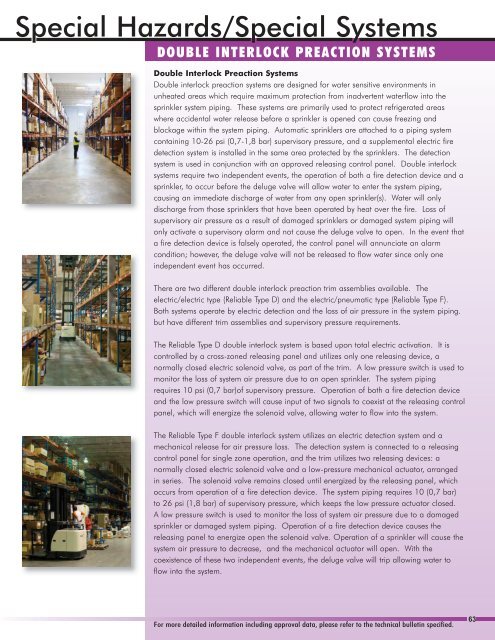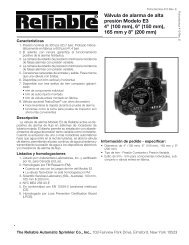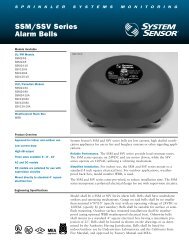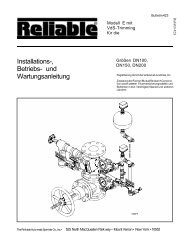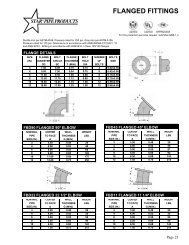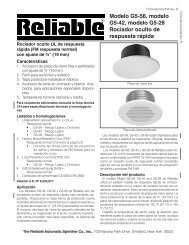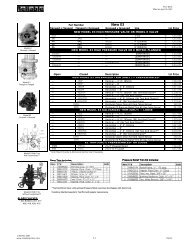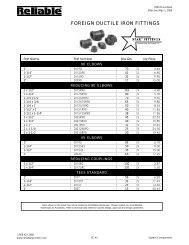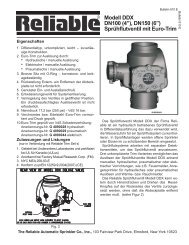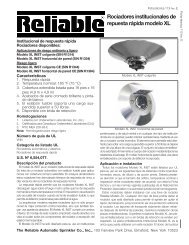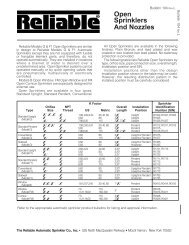Full Line 061411_Full line Brochure - Reliable Automatic Sprinkler Co.
Full Line 061411_Full line Brochure - Reliable Automatic Sprinkler Co.
Full Line 061411_Full line Brochure - Reliable Automatic Sprinkler Co.
You also want an ePaper? Increase the reach of your titles
YUMPU automatically turns print PDFs into web optimized ePapers that Google loves.
Special Hazards/Special Systems<br />
DOUBLE INTERLOCK PREACTION SYSTEMS<br />
Double Interlock Preaction Systems<br />
Double interlock preaction systems are designed for water sensitive environments in<br />
unheated areas which require maximum protection from inadvertent waterflow into the<br />
sprinkler system piping. These systems are primarily used to protect refrigerated areas<br />
where accidental water release before a sprinkler is opened can cause freezing and<br />
blockage within the system piping. <strong>Automatic</strong> sprinklers are attached to a piping system<br />
containing 10-26 psi (0,7-1,8 bar) supervisory pressure, and a supplemental electric fire<br />
detection system is installed in the same area protected by the sprinklers. The detection<br />
system is used in conjunction with an approved releasing control panel. Double interlock<br />
systems require two independent events, the operation of both a fire detection device and a<br />
sprinkler, to occur before the deluge valve will allow water to enter the system piping,<br />
causing an immediate discharge of water from any open sprinkler(s). Water will only<br />
discharge from those sprinklers that have been operated by heat over the fire. Loss of<br />
supervisory air pressure as a result of damaged sprinklers or damaged system piping will<br />
only activate a supervisory alarm and not cause the deluge valve to open. In the event that<br />
a fire detection device is falsely operated, the control panel will annunciate an alarm<br />
condition; however, the deluge valve will not be released to flow water since only one<br />
independent event has occurred.<br />
There are two different double interlock preaction trim assemblies available. The<br />
electric/electric type (<strong>Reliable</strong> Type D) and the electric/pneumatic type (<strong>Reliable</strong> Type F).<br />
Both systems operate by electric detection and the loss of air pressure in the system piping.<br />
but have different trim assemblies and supervisory pressure requirements.<br />
The <strong>Reliable</strong> Type D double interlock system is based upon total electric activation. It is<br />
controlled by a cross-zoned releasing panel and utilizes only one releasing device, a<br />
normally closed electric solenoid valve, as part of the trim. A low pressure switch is used to<br />
monitor the loss of system air pressure due to an open sprinkler. The system piping<br />
requires 10 psi (0,7 bar)of supervisory pressure. Operation of both a fire detection device<br />
and the low pressure switch will cause input of two signals to coexist at the releasing control<br />
panel, which will energize the solenoid valve, allowing water to flow into the system.<br />
The <strong>Reliable</strong> Type F double interlock system utilizes an electric detection system and a<br />
mechanical release for air pressure loss. The detection system is connected to a releasing<br />
control panel for single zone operation, and the trim utilizes two releasing devices: a<br />
normally closed electric solenoid valve and a low-pressure mechanical actuator, arranged<br />
in series. The solenoid valve remains closed until energized by the releasing panel, which<br />
occurs from operation of a fire detection device. The system piping requires 10 (0,7 bar)<br />
to 26 psi (1,8 bar) of supervisory pressure, which keeps the low pressure actuator closed.<br />
A low pressure switch is used to monitor the loss of system air pressure due to a damaged<br />
sprinkler or damaged system piping. Operation of a fire detection device causes the<br />
releasing panel to energize open the solenoid valve. Operation of a sprinkler will cause the<br />
system air pressure to decrease, and the mechanical actuator will open. With the<br />
coexistence of these two independent events, the deluge valve will trip allowing water to<br />
flow into the system.<br />
For more detailed information including approval data, please refer to the technical bulletin specified.<br />
63


